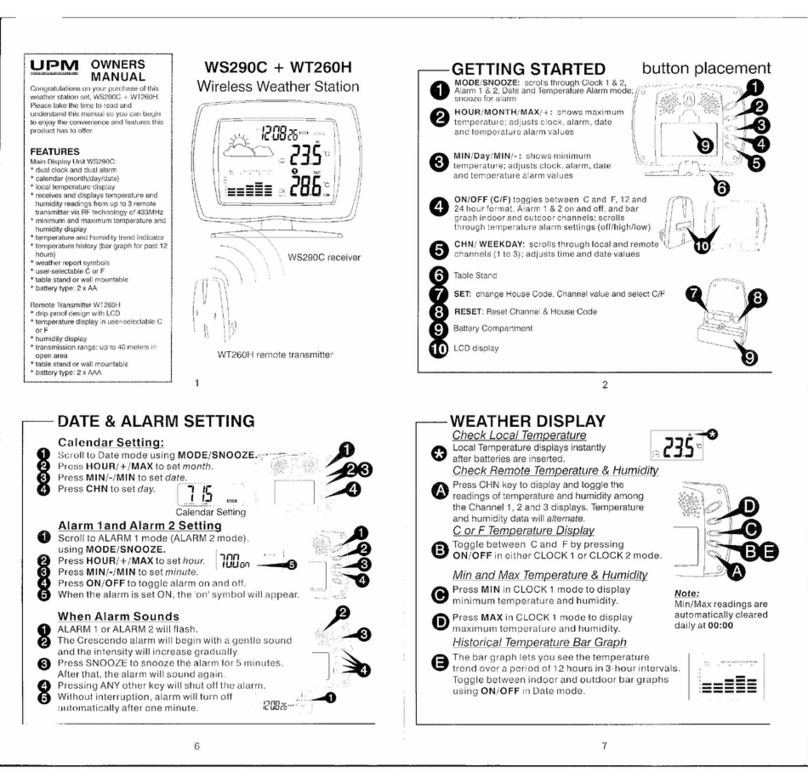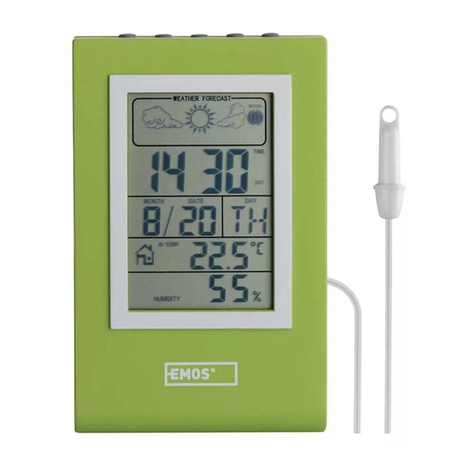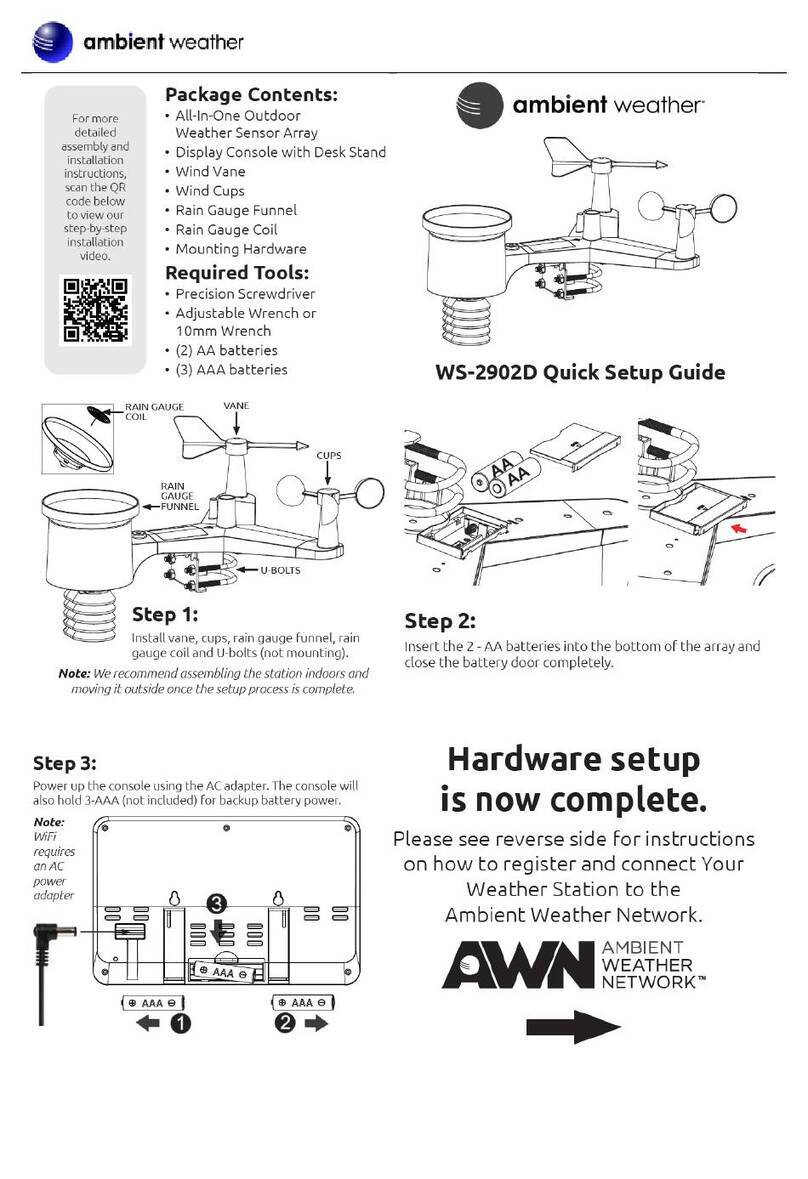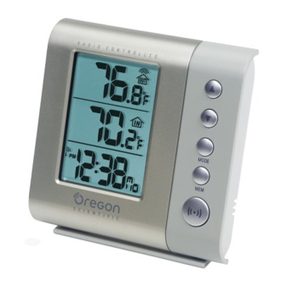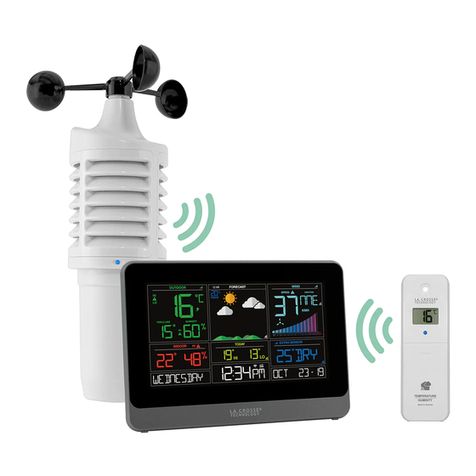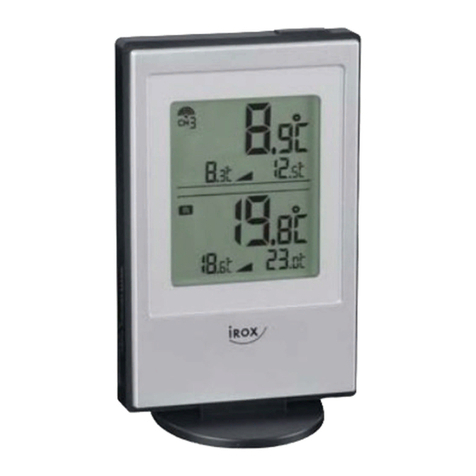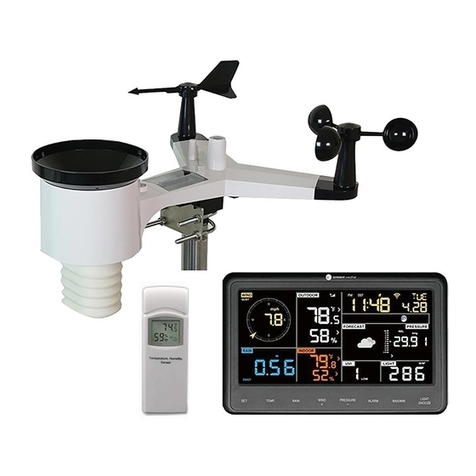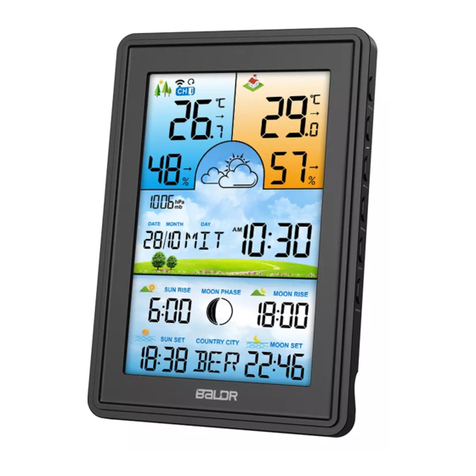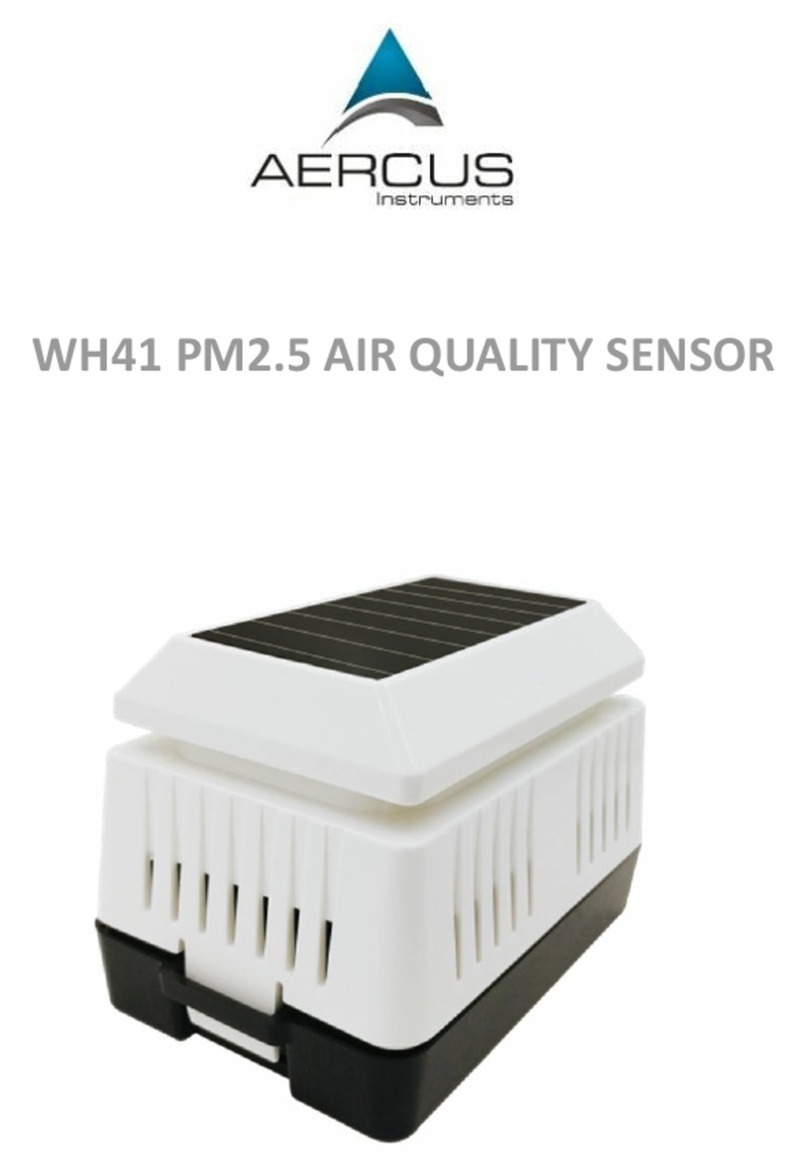Elsner P03 3 User manual

P03/3 Weather Station 1
P03/3 Weather Station • Version: 07.06.2021 • Technical changes and errors excepted. • Elsner Elektronik GmbH • Sohlengrund 16 • 75395 Ostelsheim • Germany • www.elsner-elektronik.de • Technical Service: +49 (0) 7033 / 30945-250
P03/3
Weather Station
Replacement for P00 (3-wire), P01 and P02 for controls WS1, WS10,
WS20, WS1000, WS1000 Touch, FS100 and PS8A
Technical specifications and installation instructions
Item number 30107
1. Description
The P03/3 Weather Station measures temperature, wind speed, brightness (eas-
tern, southern and western sun). It recognizes precipitation and receives the time
signal with a GPS receiver. Central European Time is output, daylight savings time
is adjusted automatically according to the specifications of central europe.
Die P03/3 serves as replacement for the 3-wire P00, the P01 or the P02 for conser-
vatory controls WS1, WS10, WS20, WS1000 and WS1000 Touch and for the facade
control FS100 and evaluation unit PS8A.
With all control models except WS1000 Touch a jumper must be placed on the
board of the waether station. Please refer to chapter “PCB Layout” auf Seite 2.
Functions:
•Brightness measurement with three separate sensors for east, south and
west. Recognition of twilight/dawn with special filters
•Wind measurement: The wind strength measurement takes place
electronically and thus noiselessly and reliably, even during hail, snow and
sub-zero temperatures. Even turbulent air and anabatic winds in the vicinity
of the weather station are recorded
• Temperature measurement
• Heated precipitation sensor (1.2 watts): No false reports as a result of fog
or dew. Dries quickly after precipitation has stopped
• Integrated GPS receiver. Output of CET (Central European Time),
automatic adjustment of daylight savings time.
1.1. Scope of delivery
• Weather station with a combination wall/pole mount
• Jumper (see chapter 2.2.4.)
1.2. Technical specifications
The product conforms with the provisions of EU directives.
2. Installation and commissioning
Installation, testing, operational start-up and troubleshooting should
only be performed by an authorised electrician.
CAUTION!
Live voltage!
There are unprotected live components inside the device.
• Inspect the device for damage before installation. Only put undamaged
devices into operation.
• Comply with the locally applicable directives, regulations and provisions
for electrical installation.
• Immediately take the device or system out of service and secure it against
unintentional switch-on if risk-free operation is no longer guaranteed.
Use the device exclusively for building automation and observe the operating ins-
tructions. Improper use, modifications to the device or failure to observe the ope-
rating instructions will invalidate any warranty or guarantee claims.
Operate the device only as a fixed-site installation, i.e. only in assembled condition
and after conclusion of all installation and operational start-up tasks, and only in
the surroundings designated for it.
Elsner Elektronik is not liable for any changes in norms and standards which may
occur after publication of these operating instructions.
2.1. Installation position
Choose an installation position in the building where wind, rain and sun can be
measured unhindered by the sensors. The weather station must not be installed
underneath any structural parts from which water can still drip onto the rain sensor
after it has stopped raining or snowing. The weather station must not be shaded
by anything, such as building structures or trees.
At least 60 cm of clearance must be left all round the weather station. This facilita-
tes correct wind speed measurement without eddies. The distance concurrently
prevents spray (raindrops hitting the device) or snow (snow penetration) from im-
pairing the measurement. It also does not allow birds to bite it.
Please take note that an extended awning does not shade the device from sun and
wind.
Temperature measurements can also be affected by external influences such as by
warming or cooling of the building structure on which the sensor is mounted, (sun-
light, heating or cold water pipes).
2.2. Mounting the sensor
2.2.1. Attaching the mount
The sensor comes with a combination wall/pole mount. The mount comes adhered
by adhesive strips to the rear side of the housing. Fasten the mount vertically onto
the wall or pole.
2.2.2. View of rear side and drill hole plan
2.2.3. Preparing the sensor
The weather station cover with the rain sensor snaps in on the left and right along
the bottom edge (see figure). Remove the weather station cover. Proceed carefully,
Housing Plastic material
Colour White / translucent
Mounting On-wall
Degree of protection IP 44
Dimensions approx. 96 × 77 × 118 (W × H × D, mm)
Weight approx. 160 g
Ambient tempera-
ture
Operation -30…+50°C, Storage -30…+70°C
Operating voltage 24 V DC
Heating rain sensor approx. 1.2 W
Measurement range
temperature
-40…+80°C
Resolution (tempe-
rature)
0.1°C
Accuracy (tempera-
ture)
±1.5°C at -25…+80°C
Measurement range
wind
0…35 m/s
Resolution (wind) 0.1 m/s
Accuracy (wind) at ambient temperature -20…+50°C:
±22% of measurement value when incident flow
45…315°
±15% of measurement value when incident flow
90…270°
(Frontal incident flow corresponds to 180°)
Measurement range
brightness
0 lux ... 99.000 lux
Resolution (bright-
ness)
1 lux at 0 … 999 lux
1 klux at 1 … 99 klux
Accuracy (bright-
ness)
±35%
Fig. 1
There must be at least 60 cm of space
below, to the sides and in front of the
weather station left from other ele-
ments (structures, construction parts,
etc.).
60 cm
Fig. 2
The weather station must be mounted
on a vertical wall (or a pole).
Wall
or
pole
Fig. 3
The weather station must be mounted
in the horizontal transverse direction
(horizontally).
Horizontal
Fig. 4
For installation in the northern hemis-
phere, the weather station must be
aligned to face south.
For installation in the southern hemis-
phere, the weather station must be
aligned to face north.
North
South
Fig. 5
When wall mounting: flat side on wall,
crescent-shaped collar upward.
Collar
Fig. 6
When pole mounting: curved side on po-
le, collar downward.
Collar
Fig. 7
Different mounting arms are available
from Elsner Elektronik as additional, op-
tional accessories for flexible installation
of the weather station on a wall, pole or
beam (pictures of sensors exemplary).
Example of the use of a mounting arm:
Due to flexible ball joints, the sensor can
be brought into ideal position.
Fig. 8
Example use of the hinge arm mounting:
With the hinge arm mounting, the weat-
her station projects from beneath the
roof overhang. Sun, wind and precipita-
tion can act upon the sensors without
hindrance.
Fig. 9
Example use of the hinge arm mounting:
Fitting to a pole with worm drive hose
clips
Langloch 7,5 x 5 mm
Fig. 10 a+b
Drill hole plan
Dimensions of rear side of housing with bra-
cket. Subject to change for technical enhan-
cement.
Fig. 11
1 Lid with rain sensor
2 Cover Snaps
3 Bottom part of hou-
sing
2
3
1
Unsnap cover and
remove upwards
EN

P03/3 Weather Station 2
P03/3 Weather Station • Version: 07.06.2021 • Technical changes and errors excepted. • Elsner Elektronik GmbH • Sohlengrund 16 • 75395 Ostelsheim • Germany • www.elsner-elektronik.de • Technical Service: +49 (0) 7033 / 30945-250
so as not to pull off the wire connecting the PCB in the bottom part with the rain
sensor in the cover (wire with push-connector).
Push the connecting cable through the rubber seal on the bottom of the weather
station and connect the power and data cables to the terminals provided for this
purpose. The supply cable to the weather station should be a maximum of 30 m
long. The connection is by typical telephone cable (J-Y(ST)Y 2 × 2 × 0.8).
The connection cable must be plugged in between the cover and circuit board.
2.2.4. PCB Layout
Set jumper:
Please reboot the system after the setting of the jumper!
2.2.5. Mounting the sensor
Close the housing by putting the cover back over the bottom part. The cover must
snap in on the left and right with a definite “click”.
To remove it, the sensor can be simply pulled upwards out of the mount, against
the resistance of the fastening.
2.3. Notes on mounting and commissioning
Do not open weather station if water (rain) might ingress: even some drops might
damage the electronic system.
Observe the correct connections. Incorrect connections may destroy the weather
station or connected electronic devices.
Please take care not to damage the temperature sensor (small blank at the bottom
part of the housing.) when mounting the weather station. Please also take care not
to break away or bend the cable connection between the blank and the rain sensor
when connecting the weather station.
Remove all existing protection labels after installation.
The correct wind value may only be supplied about 30 seconds after the supply
voltage has been connected.
2.4. Maintenance of the weather station
WARNING!
Risk of injury caused by components moved automatically!
The automatic control can start system components and place people
in danger.
• Always isolate the device from the mains for servicing and
cleaning.
The device must regularly be checked for dirt twice a year and cleaned if necessary.
In case of severe dirt, the sensor may not work properly anymore.
ATTENTION
The device can be damaged if water penetrates the housing.
• Do not clean with high pressure cleaners or steam jets.
3. Disposal
After use, the device must be disposed of or recycled in accordance with the legal
regulations. Do not dispose of it with the household waste!
Control model Jumper position
WS1000 Touch no jumper
All other models up to production year 2001 jumper at position (a)
All other models from production year 2002 on jumper at position (b)
Fig. 12: Overview PCB
1 Socket for connect-
ing cables to
rain sensor in hous-
ing cover
2 Connection plug
1: +24 V DC | 2: GND |
3: Data (massive ca-
ble up to 0.8 mm²)
3 Control LED GPS re-
ceiver
4 Socket for jumper
1
2
3
4
a
b
Fig. 13
Make sure the cover and bottom part
are properly snapped together! This
picture is looking at the closed sensor
from underneath.
Fastening
Fig. 14
Push the housing from above into the
fastened mount. The bumps on the
mount must snap into the rails in the
housing.
Fig. 15
After installation, remove the "distan-
ce" sticker on the top of the cover.
Other Elsner Weather Station manuals
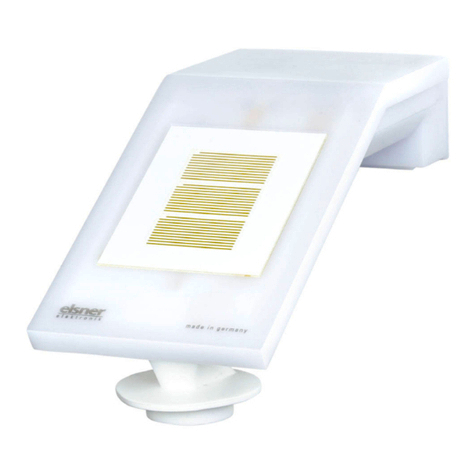
Elsner
Elsner Suntracer KNX sl Guide
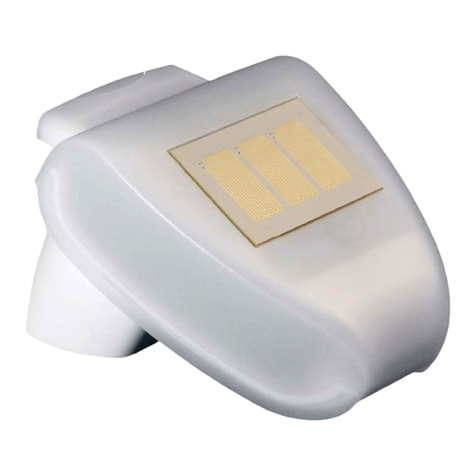
Elsner
Elsner P03/3 User manual
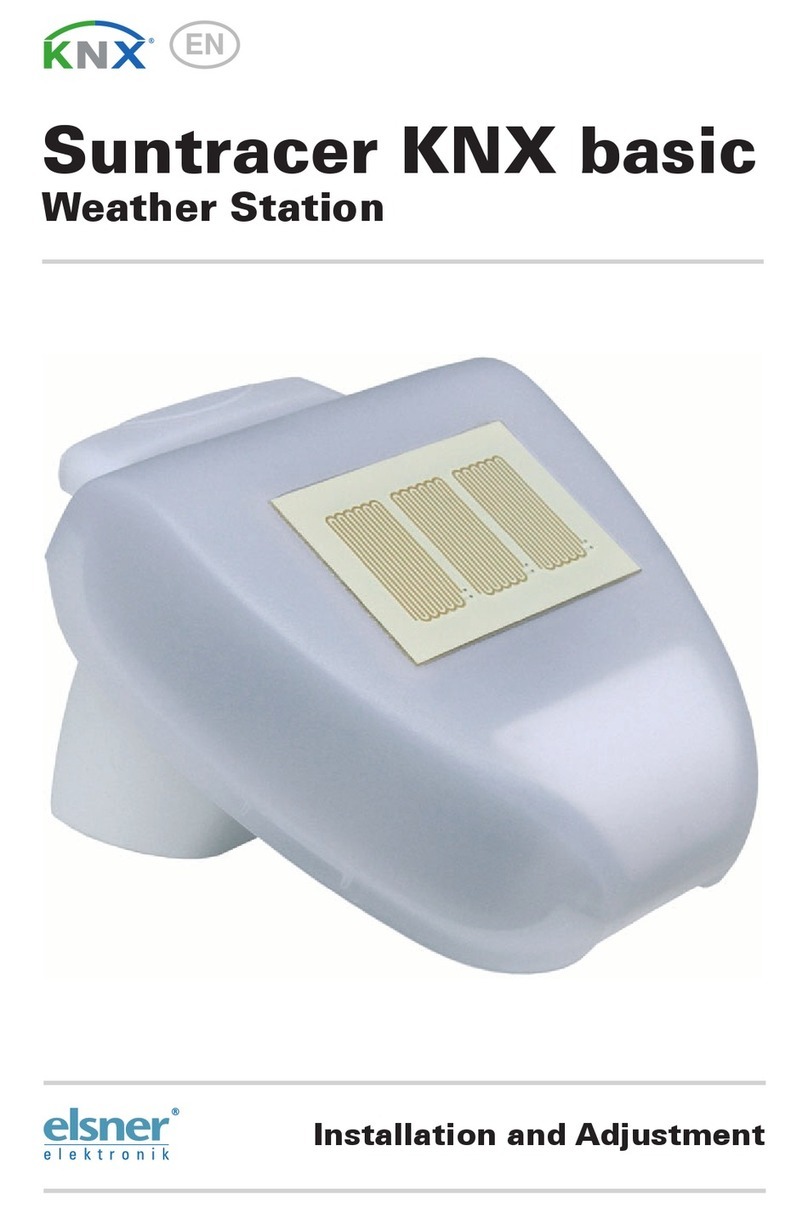
Elsner
Elsner Suntracer KNX basic Guide
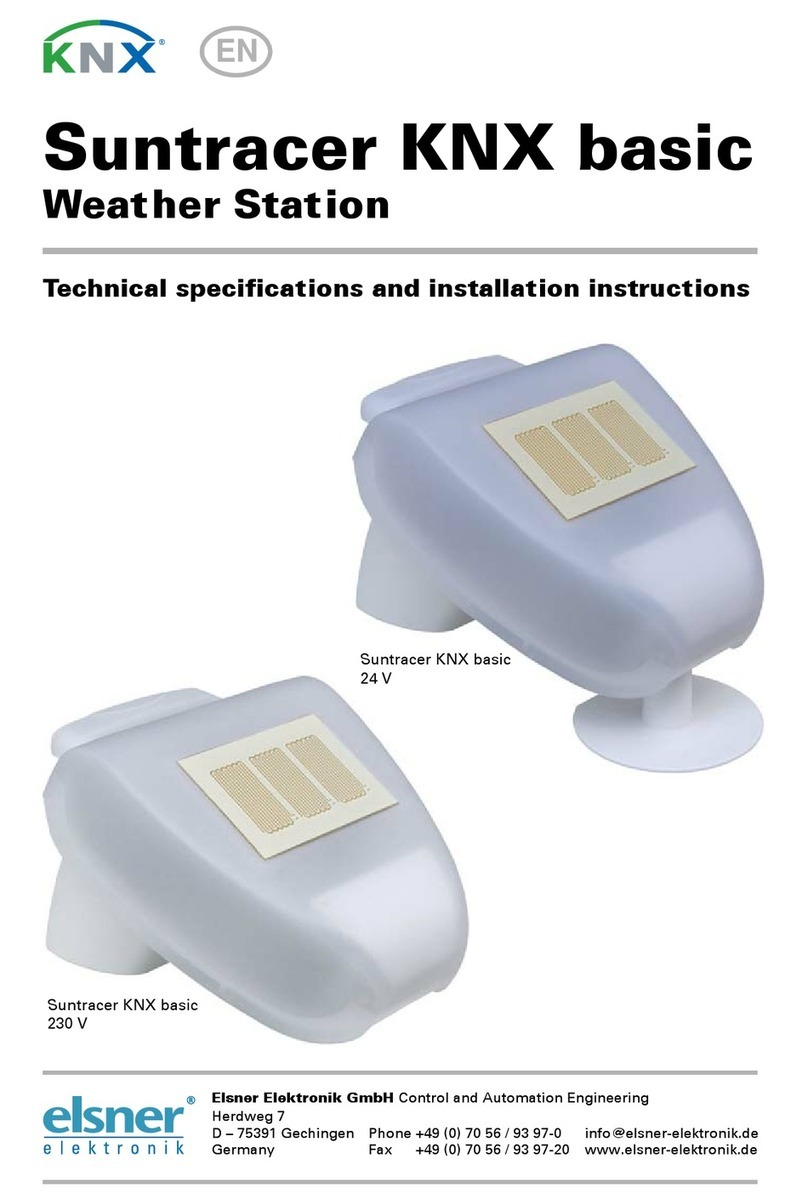
Elsner
Elsner Suntracer KNX basic Series User manual
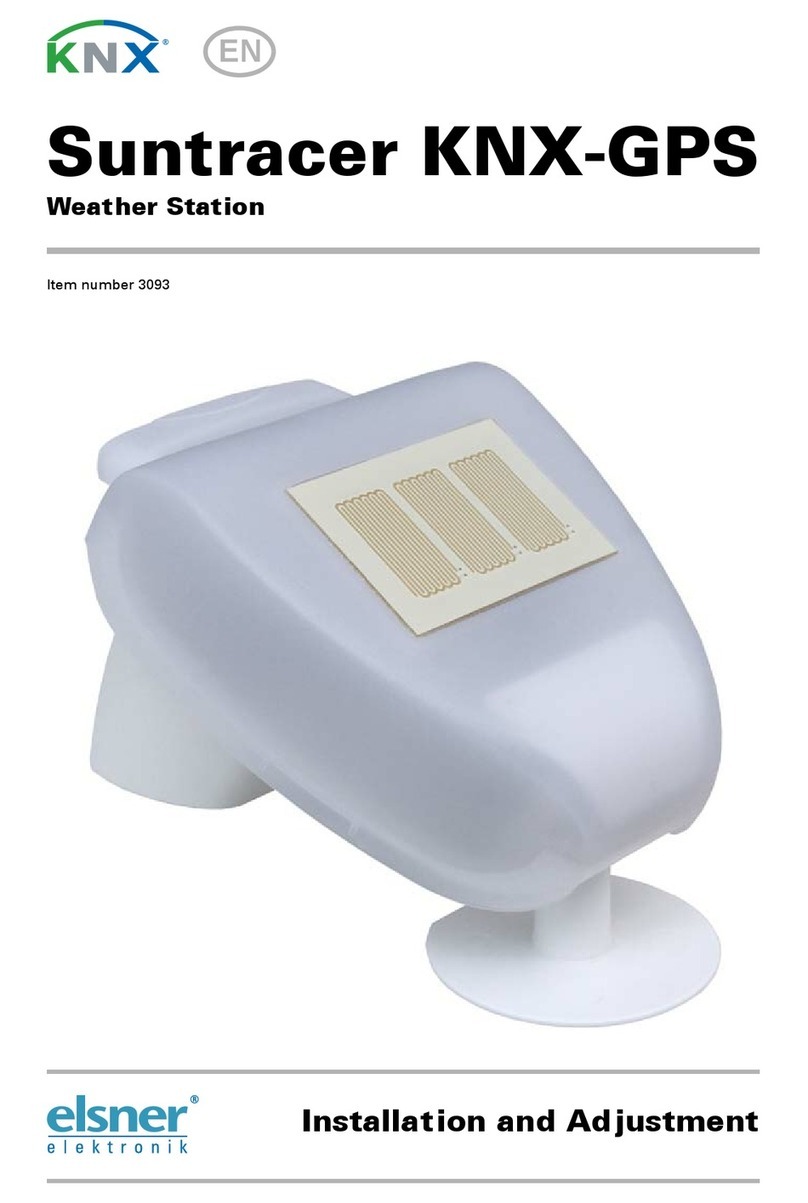
Elsner
Elsner Suntracer KNX-GPS Guide
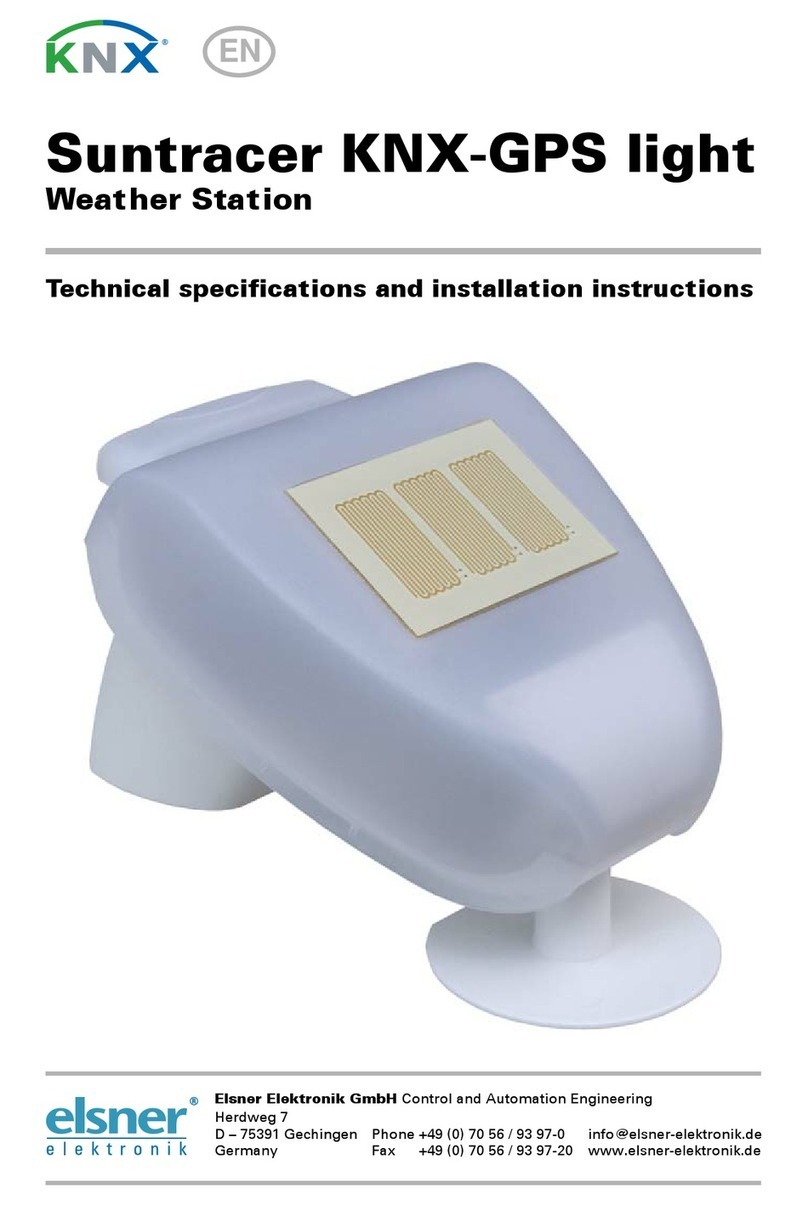
Elsner
Elsner Suntracer KNX-GPS User manual
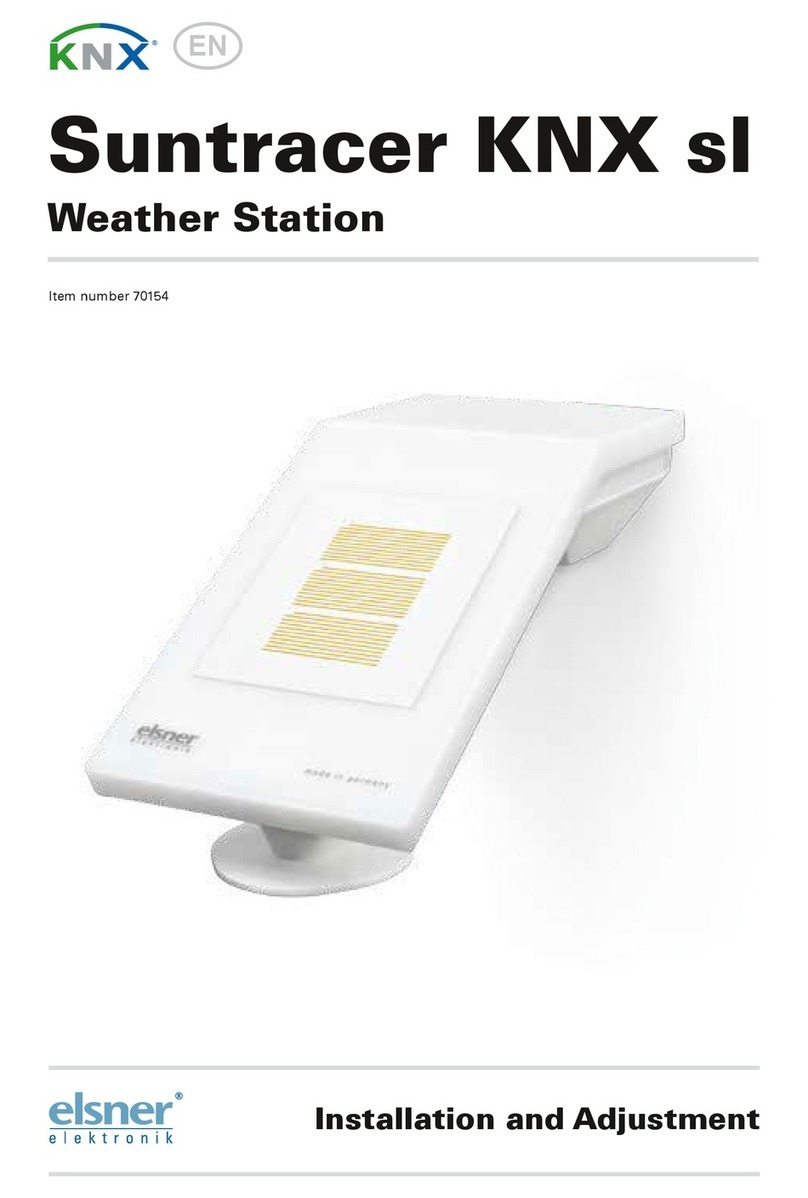
Elsner
Elsner Suntracer KNX sl Guide
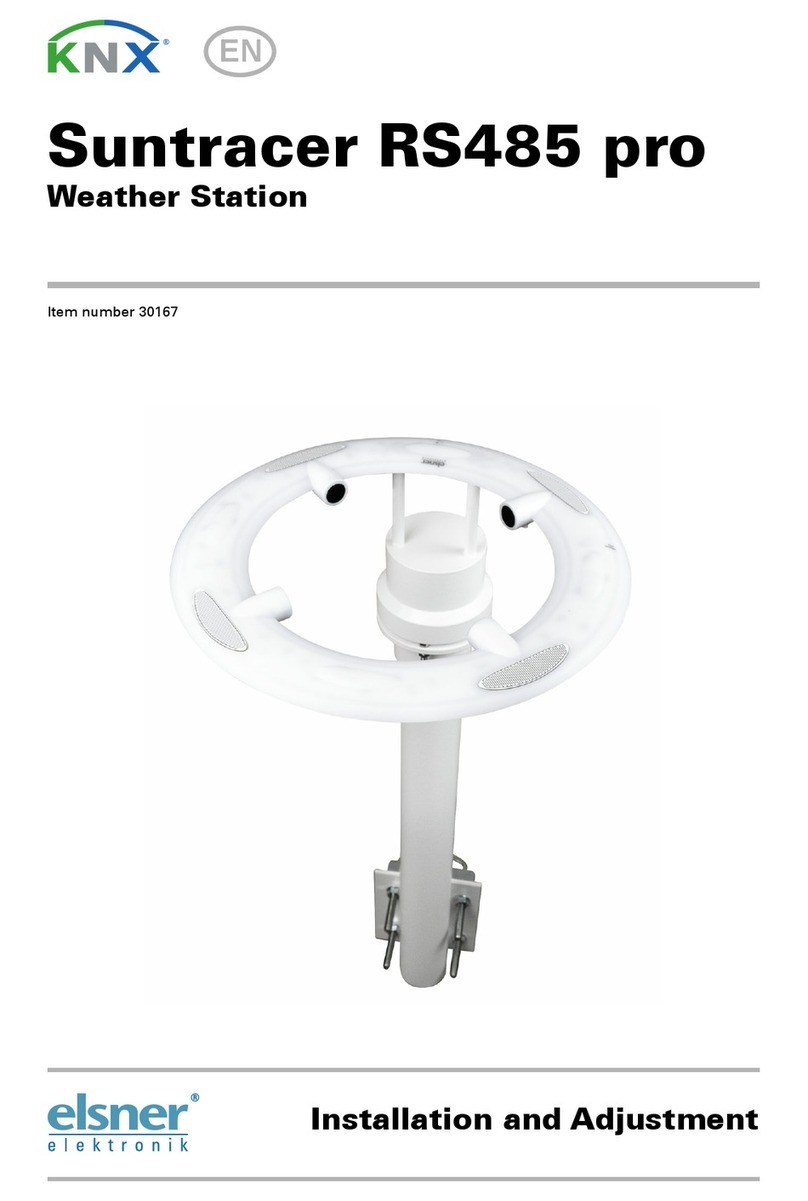
Elsner
Elsner KNX Suntracer pro Guide
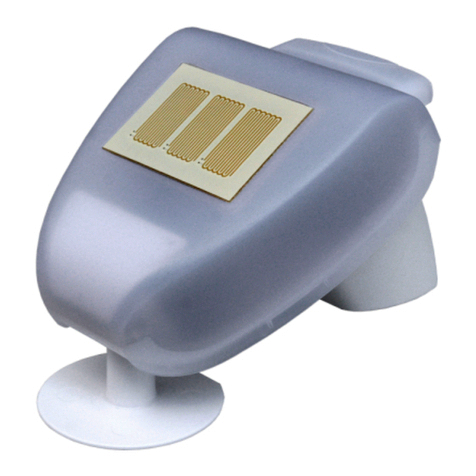
Elsner
Elsner Suntracer KNX basic Guide
